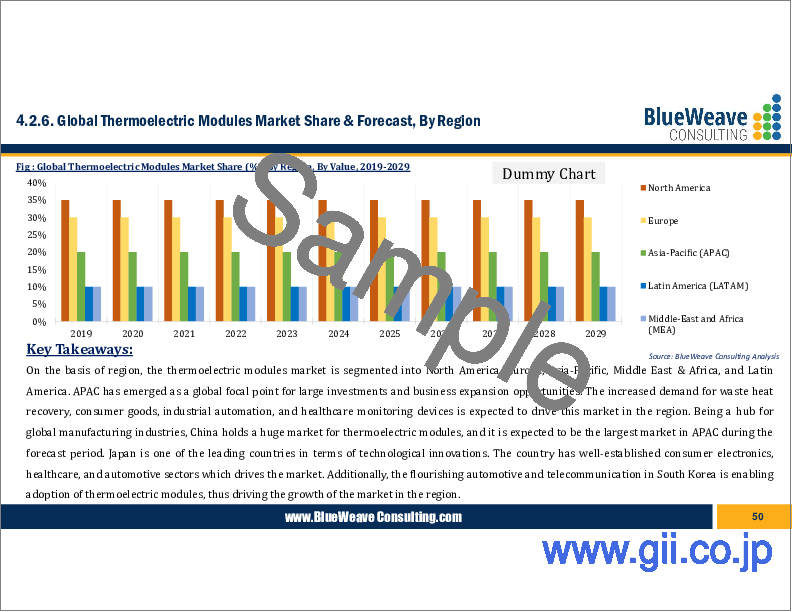|
|
市場調査レポート
商品コード
1319268
熱電モジュール市場:世界の市場規模、シェア、動向分析、機会、予測レポート、2019-2029年Thermoelectric Modules Market - Global Size, Share, Trend Analysis, Opportunity and Forecast Report, 2019-2029, Segmented By Model ; By Type ; By End Use ; By Region |
||||||
|
|||||||
| 熱電モジュール市場:世界の市場規模、シェア、動向分析、機会、予測レポート、2019-2029年 |
|
出版日: 2023年07月17日
発行: Blueweave Consulting
ページ情報: 英文 400 Pages
納期: 2~3営業日
|
- 全表示
- 概要
- 目次
熱電モジュールの世界市場規模は2029年までに11億3,000万米ドルに達する勢い
世界の熱電モジュール市場は、電子機器や医療機器における精密な温度制御へのニーズの高まりと、再生可能エネルギー源からのエネルギー発電への注目の高まりにより、活況を呈しています。
戦略コンサルティングと市場調査の大手企業であるBlueWeave Consultingは最近の調査で、2022年の世界の熱電モジュール市場規模を6億8,500万米ドルと推定しました。2023年から2029年までの予測期間中、BlueWeaveは、世界の熱電モジュール市場規模がCAGR 8.95%の著しい成長を遂げ、2029年には11億2,600万米ドルに達すると予測しています。世界の熱電モジュール市場の主な成長促進要因には、電子機器における熱電モジュールの利用の増加、電気自動車やハイエンド自動車アプリケーションにおけるこれらのモジュールの統合の拡大などがあります。熱電モジュールはエネルギー効率の高い冷却・加熱ソリューションを提供し、持続可能性と省エネルギーへの関心の高まりに合致しています。産業界と消費者がより環境に優しい代替品を求めるにつれて、熱電モジュールの需要が急増しています。また、スマートフォン、ウェアラブルデバイス、IoT対応ガジェットなどの電子機器における技術進歩の急速な採用が、サーモエレクトリック・モジュールの需要に拍車をかけています。これらのモジュールは電子機器に効果的な冷却ソリューションを提供し、最適な性能と信頼性を保証します。これらの側面が、予測期間中に市場全体の成長を拡大する原動力になると予想されます。しかし、従来の冷却または加熱システムと比較した熱電モジュールの高コストと、現在のサーモエレクトリック技術の限られた効率と出力が、分析期間中の市場全体の成長を抑制すると予想されています。
本レポートの詳細な分析により、世界の熱電モジュール市場の成長可能性、今後の動向、統計に関する情報を提供します。また、総市場規模の予測を促進する要因も取り上げています。本レポートは、世界の熱電モジュール市場の最新技術動向や、意思決定者が的確な戦略的意思決定を行えるような業界洞察を提供することをお約束します。さらに、市場の成長促進要因・課題・競争力についても分析しています。
目次
第1章 調査の枠組み
第2章 エグゼクティブサマリー
第3章 世界の熱電モジュール市場に関する洞察
- 業界のバリューチェーン分析
- DROC分析
- 成長の原動力
- さまざまな業界でエネルギー効率の高いソリューションに対する需要が高まっています
- 再生可能エネルギー源への注目の高まり
- 電子機器や医療機器における正確な温度制御のニーズの高まり
- 抑制要因
- 従来の冷却または加熱システムと比較して熱電モジュールのコストが高い
- 現在の熱電技術の効率と出力には限界がある
- 機会
- 廃熱回収などの自動車用途における熱電モジュールの採用が増加
- 医療機器、航空宇宙、防衛分野における熱電モジュールの需要の増大
- 課題
- エンドユーザーの間での熱電技術の認識と理解が限られている
- 熱電材料と廃熱処理に関連する環境問題への対処
- 成長の原動力
- 技術の進歩/最近の開発
- 規制の枠組み
- ポーターのファイブフォース分析
第4章 世界の熱電モジュール市場概要
- 市場規模と予測、2019~2029年
- 金額別
- 市場シェアと予測
- モデル別
- シングルステージ
- マルチステージ
- タイプ別
- バルク熱電モジュール
- マイクロ熱電モジュール
- 薄膜熱電モジュール
- 最終用途別
- 航空宇宙と防衛
- 自動車
- 家電
- ヘルスケア
- エネルギーとユーティリティ
- その他
- 地域別
- 北米
- 欧州
- アジア太平洋(APAC)
- ラテンアメリカ(LATAM)
- 中東およびアフリカ(MEA)
- モデル別
第5章 北米の熱電モジュール市場
- 市場規模と予測、2019~2029年
- 金額別
- 市場シェアと予測
- モデル別
- タイプ別
- 最終用途別
- 国別
- 米国
- カナダ
第6章 欧州の熱電モジュール市場
- 市場規模と予測、2019~2029年
- 金額別
- 市場シェアと予測
- モデル別
- タイプ別
- 最終用途別
- 国別
- ドイツ
- 英国
- イタリア
- フランス
- スペイン
- ベルギー
- ロシア
- オランダ
- その他欧州
第7章 アジア太平洋の熱電モジュール市場
- 市場規模と予測、2019~2029年
- 金額別
- 市場シェアと予測
- モデル別
- タイプ別
- 最終用途別
- 国別
- 中国
- インド
- 日本
- 韓国
- オーストラリアとニュージーランド
- インドネシア
- マレーシア
- シンガポール
- ベトナム
- APACのその他諸国
第8章 ラテンアメリカの熱電モジュール市場
- 市場規模と予測、2019~2029年
- 金額別
- 市場シェアと予測
- モデル別
- タイプ別
- 最終用途別
- 国別
- ブラジル
- メキシコ
- アルゼンチン
- ペルー
- 中南米の残りの地域
第9章 中東およびアフリカの熱電モジュール市場
- 市場規模と予測、2019~2029年
- 金額別
- 市場シェアと予測
- モデル別
- タイプ別
- 最終用途別
- 国別
- サウジアラビア
- アラブ首長国連邦
- カタール
- クウェート
- 南アフリカ
- ナイジェリア
- アルジェリア
- MEAの残りの部分
第10章 競合情勢
- 主要企業とその製品のリスト
- 世界の熱電モジュール市場シェア分析、2022年
- 経営パラメータによる競合ベンチマーキング
- 主要な戦略的展開(合併、買収、パートナーシップなど)
第11章 世界の熱電モジュール市場に対するCOVID-19の影響
第12章 企業プロファイル(会社概要、財務マトリックス、競合情勢、主要な人材、主要な競合、連絡先住所、戦略的展望、 SWOT分析)
- Ferrotec Corporation
- Laird Thermal Systems
- II-VI Incorporated
- TE Technology
- RMT Ltd.
- KELK Ltd.
- Crystal Ltd.
- Kryotherm
- Phononic
- TEC Microsystems GmbH
- Guangdong Fuxin Technology Co., Ltd.
- Hi-Z Technology, Inc.
- EVERREDtronics Ltd.
- Thermonamic Electronics(Jiangxi)Corp.
- Alphabet Energy Inc.
- Other Prominent Players
第13章 主要な戦略的推奨事項
第14章 調査手法
Global Thermoelectric Modules Market Size Booming to Touch USD 1.13 Billion by 2029.
Global thermoelectric modules market is flourishing because of an increasing need for precise temperature control in electronics and medical devices, and a growing focus on generating energy from renewable sources.
BlueWeave Consulting, a leading strategic consulting and market research firm, in its recent study, estimated the global thermoelectric modules market size at USD 685 million in 2022. During the forecast period between 2023 and 2029, BlueWeave expects global thermoelectric modules market size to grow at a significant CAGR of 8.95% reaching a value of USD 1,126 million by 2029. Major growth drivers for the global thermoelectric modules market include an increasing utilization of thermoelectric modules in electronic devices and the expanding integration of these modules in electric and high-end automobile applications. Thermoelectric modules offer energy-efficient cooling and heating solutions, which align with the increasing focus on sustainability and energy conservation. As industries and consumers seek greener alternatives, the demand for thermoelectric modules has surged. Also, the rapid adoption of technological advancements in electronic devices, such as smartphones, wearable devices, and IoT-enabled gadgets, has spurred the demand for thermoelectric modules. These modules provide effective cooling solutions for electronics, ensuring optimal performance and reliability. These aspects are expected to drive the expansion of the overall market growth during the forecast period. However, high cost of thermoelectric modules compared to conventional cooling or heating systems and limited efficiency and power output of current thermoelectric technologies are anticipated to restrain the overall market growth during the period in analysis.
Global Thermoelectric Modules Market - Overview:
The global thermoelectric modules market refers to the industry involved in the production and supply of packaging solutions specifically designed for temperature-sensitive products during transportation and storage. These packaging solutions are essential for maintaining the integrity, quality, and safety of perishable goods, such as food, pharmaceuticals, and biotechnology products, by controlling and preserving their temperature within a specified range. The market encompasses a range of packaging types, including insulated shippers, containers, refrigerants, and temperature-controlled packaging systems. It serves various sectors, including food and beverages, pharmaceuticals and healthcare, chemicals, and others. The market's growth is driven by factors, such as increasing globalization of trade, expanding pharmaceutical and healthcare sectors, growing demand for convenience foods, and stricter regulations regarding product safety and quality.
Impact of COVID-19 on Global Thermoelectric Modules Market:
COVID-19 pandemic had a dual impact on the global thermoelectric modules market. Initially, the global thermoelectric modules market was affected due to supply chain disruptions, manufacturing shutdowns, and reduced demand across industries. The automotive and electronics sectors, major consumers of thermoelectric modules, were particularly affected. However, the pandemic also created new opportunities as the need for accurate temperature control in healthcare devices and equipment increased. The demand for thermoelectric modules in medical applications, such as vaccine storage and diagnostic equipment, surged. As the global economy recovers in the post pandemic era, the growth in the global thermoelectric modules market is expected to rebound, driven by an increasing demand for energy-efficient solutions and advancements in major end-use sectors, including automotive and electronics.
Global Thermoelectric Modules Market - By End Use:
Based on end use, the global thermoelectric modules market is segmented into Aerospace & Defense, Automotive, Consumer Electronics, Healthcare, and Energy & Utilities segments. The consumer electronics segment dominates the global thermoelectric modules market. There is a rising demand for smart devices, wearable technology, and portable electronics, which require efficient temperature management for optimal performance. Thermoelectric modules offer precise cooling and heating capabilities, ensuring the smooth operation of these devices. The growing adoption of thermoelectric modules in refrigeration systems for food storage and beverage cooling further drives the growth of the consumer electronics segment. Also, the increasing focus on energy efficiency and sustainable solutions in consumer electronics contributes to the preference for thermoelectric modules, solidifying their position as the largest segment in the global thermoelectric modules market by end use.
Competitive Landscape:
Major players operating in the global thermoelectric modules market include: Ferrotec Corporation, Laird Thermal Systems, II-VI Incorporated, TE Technology, RMT Ltd., KELK Ltd., Crystal Ltd, Kryotherm, Phononic, TEC Microsystems GmbH, Guangdong Fuxin Technology Co., Ltd, Hi-Z Technology, Inc., EVERREDtronics Ltd, Thermonamic Electronics (Jiangxi) Corp., and Alphabet Energy Inc. To further enhance their market share, these companies employ various strategies, including mergers and acquisitions, partnerships, joint ventures, license agreements, and new product launches.
The in-depth analysis of the report provides information about growth potential, upcoming trends, and statistics of Global Thermoelectric Modules Market. It also highlights the factors driving forecasts of total market size. The report promises to provide recent technology trends in Global Thermoelectric Modules Market and industry insights to help decision-makers make sound strategic decisions. Furthermore, the report also analyzes the growth drivers, challenges, and competitive dynamics of the market.
Table of Contents
1. Research Framework
- 1.1. Research Objective
- 1.2. Product Overview
- 1.3. Market Segmentation
2. Executive Summary
3. Global Thermoelectric Modules Market Insights
- 3.1. Industry Value Chain Analysis
- 3.2. DROC Analysis
- 3.2.1. Growth Drivers
- 3.2.1.1. Increasing demand for energy-efficient solutions in various industries
- 3.2.1.2. Growing focus on renewable energy sources
- 3.2.1.3. Rising need for precise temperature control in electronics and medical devices
- 3.2.2. Restraints
- 3.2.2.1. High cost of thermoelectric modules compared to conventional cooling or heating systems
- 3.2.2.2. Limited efficiency and power output of current thermoelectric technologies
- 3.2.3. Opportunities
- 3.2.3.1. Increasing adoption of thermoelectric modules in automotive applications, such as waste heat recovery
- 3.2.3.2. Growing demand for thermoelectric modules in medical devices, aerospace, and defense sectors
- 3.2.4. Challenges
- 3.2.4.1. Limited awareness and understanding of thermoelectric technology among end users
- 3.2.4.2. Addressing environmental concerns associated with thermoelectric materials and waste heat disposal
- 3.2.1. Growth Drivers
- 3.3. Technology Advancements/Recent Developments
- 3.4. Regulatory Framework
- 3.5. Porter's Five Forces Analysis
- 3.5.1. Bargaining Power of Suppliers
- 3.5.2. Bargaining Power of Buyers
- 3.5.3. Threat of New Entrants
- 3.5.4. Threat of Substitutes
- 3.5.5. Intensity of Rivalry
4. Global Thermoelectric Modules Market Overview
- 4.1. Market Size & Forecast, 2019-2029
- 4.1.1. By Value (USD Million)
- 4.2. Market Share and Forecast
- 4.2.1. By Model
- 4.2.1.1. Single Stage
- 4.2.1.2. Multi-Stage
- 4.2.2. By Type
- 4.2.2.1. Bulk Thermoelectric Modules
- 4.2.2.2. Micro Thermoelectric Modules
- 4.2.2.3. Thin-Film Thermoelectric Modules
- 4.2.3. By End Use
- 4.2.3.1. Aerospace & Defense
- 4.2.3.2. Automotive
- 4.2.3.3. Consumer Electronics
- 4.2.3.4. Healthcare
- 4.2.3.5. Energy & Utilities
- 4.2.3.6. Others
- 4.2.4. By Region
- 4.2.4.1. North America
- 4.2.4.2. Europe
- 4.2.4.3. Asia Pacific (APAC)
- 4.2.4.4. Latin America (LATAM)
- 4.2.4.5. Middle East and Africa (MEA)
- 4.2.1. By Model
5. North America Thermoelectric Modules Market
- 5.1. Market Size & Forecast, 2019-2029
- 5.1.1. By Value (USD Million)
- 5.2. Market Share & Forecast
- 5.2.1. By Model
- 5.2.2. By Type
- 5.2.3. By End Use
- 5.2.4. By Country
- 5.2.4.1. United States
- 5.2.4.1.1. By Model
- 5.2.4.1.2. By Type
- 5.2.4.1.3. By End Use
- 5.2.4.2. Canada
- 5.2.4.2.1. By Model
- 5.2.4.2.2. By Type
- 5.2.4.2.3. By End Use
6. Europe Thermoelectric Modules Market
- 6.1. Market Size & Forecast, 2019-2029
- 6.1.1. By Value (USD Million)
- 6.2. Market Share & Forecast
- 6.2.1. By Model
- 6.2.2. By Type
- 6.2.3. By End Use
- 6.2.4. By Country
- 6.2.4.1. Germany
- 6.2.4.1.1. By Model
- 6.2.4.1.2. By Type
- 6.2.4.1.3. By End Use
- 6.2.4.2. United Kingdom
- 6.2.4.2.1. By Model
- 6.2.4.2.2. By Type
- 6.2.4.2.3. By End Use
- 6.2.4.3. Italy
- 6.2.4.3.1. By Model
- 6.2.4.3.2. By Type
- 6.2.4.3.3. By End Use
- 6.2.4.4. France
- 6.2.4.4.1. By Model
- 6.2.4.4.2. By Type
- 6.2.4.4.3. By End Use
- 6.2.4.5. Spain
- 6.2.4.5.1. By Model
- 6.2.4.5.2. By Type
- 6.2.4.5.3. By End Use
- 6.2.4.6. Belgium
- 6.2.4.6.1. By Model
- 6.2.4.6.2. By Type
- 6.2.4.6.3. By End Use
- 6.2.4.7. Russia
- 6.2.4.7.1. By Model
- 6.2.4.7.2. By Type
- 6.2.4.7.3. By End Use
- 6.2.4.8. The Netherlands
- 6.2.4.8.1. By Model
- 6.2.4.8.2. By Type
- 6.2.4.8.3. By End Use
- 6.2.4.9. Rest of Europe
- 6.2.4.9.1. By Model
- 6.2.4.9.2. By Type
- 6.2.4.9.3. By End Use
7. Asia-Pacific Thermoelectric Modules Market
- 7.1. Market Size & Forecast, 2019-2029
- 7.1.1. By Value (USD Million)
- 7.2. Market Share & Forecast
- 7.2.1. By Model
- 7.2.2. By Type
- 7.2.3. By End Use
- 7.2.4. By Country
- 7.2.4.1. China
- 7.2.4.1.1. By Model
- 7.2.4.1.2. By Type
- 7.2.4.1.3. By End Use
- 7.2.4.2. India
- 7.2.4.2.1. By Model
- 7.2.4.2.2. By Type
- 7.2.4.2.3. By End Use
- 7.2.4.3. Japan
- 7.2.4.3.1. By Model
- 7.2.4.3.2. By Type
- 7.2.4.3.3. By End Use
- 7.2.4.4. South Korea
- 7.2.4.4.1. By Model
- 7.2.4.4.2. By Type
- 7.2.4.4.3. By End Use
- 7.2.4.5. Australia & New Zealand
- 7.2.4.5.1. By Model
- 7.2.4.5.2. By Type
- 7.2.4.5.3. By End Use
- 7.2.4.6. Indonesia
- 7.2.4.6.1. By Model
- 7.2.4.6.2. By Type
- 7.2.4.6.3. By End Use
- 7.2.4.7. Malaysia
- 7.2.4.7.1. By Model
- 7.2.4.7.2. By Type
- 7.2.4.7.3. By End Use
- 7.2.4.8. Singapore
- 7.2.4.8.1. By Model
- 7.2.4.8.2. By Type
- 7.2.4.8.3. By End Use
- 7.2.4.9. Vietnam
- 7.2.4.9.1. By Model
- 7.2.4.9.2. By Type
- 7.2.4.9.3. By End Use
- 7.2.4.10. Rest of APAC
- 7.2.4.10.1. By Model
- 7.2.4.10.2. By Type
- 7.2.4.10.3. By End Use
8. Latin America Thermoelectric Modules Market
- 8.1. Market Size & Forecast, 2019-2029
- 8.1.1. By Value (USD Million)
- 8.2. Market Share & Forecast
- 8.2.1. By Model
- 8.2.2. By Type
- 8.2.3. By End Use
- 8.2.4. By Country
- 8.2.4.1. Brazil
- 8.2.4.1.1. By Model
- 8.2.4.1.2. By Type
- 8.2.4.1.3. By End Use
- 8.2.4.2. Mexico
- 8.2.4.2.1. By Model
- 8.2.4.2.2. By Type
- 8.2.4.2.3. By End Use
- 8.2.4.3. Argentina
- 8.2.4.3.1. By Model
- 8.2.4.3.2. By Type
- 8.2.4.3.3. By End Use
- 8.2.4.4. Peru
- 8.2.4.4.1. By Model
- 8.2.4.4.2. By Type
- 8.2.4.4.3. By End Use
- 8.2.4.5. Rest of LATAM
- 8.2.4.5.1. By Model
- 8.2.4.5.2. By Type
- 8.2.4.5.3. By End Use
9. Middle East & Africa Thermoelectric Modules Market
- 9.1. Market Size & Forecast, 2019-2029
- 9.1.1. By Value (USD Million)
- 9.2. Market Share & Forecast
- 9.2.1. By Model
- 9.2.2. By Type
- 9.2.3. By End Use
- 9.2.4. By Country
- 9.2.4.1. Saudi Arabia
- 9.2.4.1.1. By Model
- 9.2.4.1.2. By Type
- 9.2.4.1.3. By End Use
- 9.2.4.2. UAE
- 9.2.4.2.1. By Model
- 9.2.4.2.2. By Type
- 9.2.4.2.3. By End Use
- 9.2.4.3. Qatar
- 9.2.4.3.1. By Model
- 9.2.4.3.2. By Type
- 9.2.4.3.3. By End Use
- 9.2.4.4. Kuwait
- 9.2.4.4.1. By Model
- 9.2.4.4.2. By Type
- 9.2.4.4.3. By End Use
- 9.2.4.5. South Africa
- 9.2.4.5.1. By Model
- 9.2.4.5.2. By Type
- 9.2.4.5.3. By End Use
- 9.2.4.6. Nigeria
- 9.2.4.6.1. By Model
- 9.2.4.6.2. By Type
- 9.2.4.6.3. By End Use
- 9.2.4.7. Algeria
- 9.2.4.7.1. By Model
- 9.2.4.7.2. By Type
- 9.2.4.7.3. By End Use
- 9.2.4.8. Rest of MEA
- 9.2.4.8.1. By Model
- 9.2.4.8.2. By Type
- 9.2.4.8.3. By End Use
10. Competitive Landscape
- 10.1. List of Key Players and Their Offerings
- 10.2. Global Thermoelectric Modules Market Share Analysis, 2022
- 10.3. Competitive Benchmarking, By Operating Parameters
- 10.4. Key Strategic Developments (Mergers, Acquisitions, Partnerships, etc.)
11. Impact of Covid-19 on Global Thermoelectric Modules Market
12. Company Profile (Company Overview, Financial Matrix, Competitive Landscape, Key Personnel, Key Competitors, Contact Address, Strategic Outlook, SWOT Analysis)
- 12.1. Ferrotec Corporation
- 12.2. Laird Thermal Systems
- 12.3. II-VI Incorporated
- 12.4. TE Technology
- 12.5. RMT Ltd.
- 12.6. KELK Ltd.
- 12.7. Crystal Ltd.
- 12.8. Kryotherm
- 12.9. Phononic
- 12.10. TEC Microsystems GmbH
- 12.11. Guangdong Fuxin Technology Co., Ltd.
- 12.12. Hi-Z Technology, Inc.
- 12.13. EVERREDtronics Ltd.
- 12.14. Thermonamic Electronics (Jiangxi) Corp.
- 12.15. Alphabet Energy Inc.
- 12.16. Other Prominent Players
13. Key Strategic Recommendations
14. Research Methodology
- 14.1. Qualitative Research
- 14.1.1. Primary & Secondary Research
- 14.2. Quantitative Research
- 14.3. Market Breakdown & Data Triangulation
- 14.3.1. Secondary Research
- 14.3.2. Primary Research
- 14.4. Breakdown of Primary Research Respondents, By Region
- 14.5. Assumptions & Limitations






